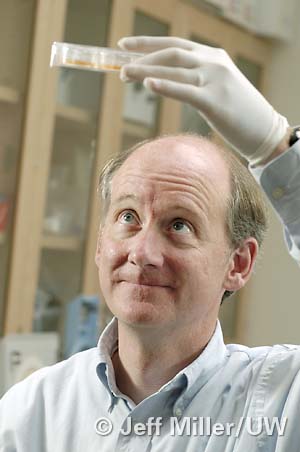Big Catch
UCSB Snags Father of Stem-Cell Research
Jamie Thomson, the reputed “father of stem-cell research,” will soon be operating a research lab in Santa Barbara as an adjunct professor at UCSB. Thomson will be in Santa Barbara about one month per year, leading an interdisciplinary team of about four postdoctoral researchers. The bulk of his work will remain centered at the University of Wisconsin at Madison, where he remains a tenured senior faculty member. Thomson made the cover of TIME magazine in 1998 for being the first to isolate a human embryonic stem cell. Because embryonic stem cells have the unique capacity to morph into any kind of cell in the human body, medical researchers regard their potential medicinal value as unlimited.

Likewise, biotechnology firms regard stem-cell research as a happy mixture of the Holy Grail and the Fountain of Youth. But because stem-cell lines come either from aborted fetuses or from unused embryos created by in vitro fertilization, many in the anti-abortion movement have opposed their use. President George W. Bush has limited federal stem-cell research funding to those stem-cell lines that already exist, but has barred funding for anything more.
However limited, Thomson’s appointment remains a huge feat for UCSB’s fledgling stem-cell program. In the world of stem-cell research, Thomson is an unassuming superstar, a one-time veterinarian and currently a John D. MacArthur Professor at the University of Wisconsin School of Medicine and Public Health. While UCSB has just been awarded $1.2 million in training grants for stem-cell research by the California Institute for Regenerative Medicine, it has been a relatively minor player when compared to giants in the field like UC San Francisco, UC San Diego, and Stanford. Thomson’s arrival will go a long way toward changing UCSB’s profile in biotechnology. Campus officials suggest Thomson has been impressed by the campus’s culture of multidisciplinary collaboration.
On a less formal basis, he’s already been working with several campus researchers for a couple of years, including the engineering department and a number of marine biologists studying simple aquatic organisms to better understand the basic mechanics of how stem cells finally “choose” what kind of cells they eventually become. In the lab, stem cells only partially evolve into what they’re supposed to become. The remainder of the unevolved cell contains genetic material that can be harmful. Thomson has already been working with a UCSB engineering professor, Tom Soh, on how to separate out the material that does not evolve as it should.
California clearly took the lead nationally in stem-cell research when voters two years ago approved spending $3 billion over the next 10 years to underwrite such scientific work. Voters were almost as won over by the prospect of a biotech gold rush as they were by the promise of medical breakthroughs. As a result, 25 prominent players in the stem-cell field have moved to California in the past year. “This is a great coup for Santa Barbara. He is one of the finest-if not the very finest-
researcher in the field,” said Dale Carlson, spokesperson for the California Institute for Regenerative Medicine, which was created to administer the $3 billion state bond.
Thomson will be in town May 1 to deliver a lecture on the implications of stem-cell science on cancer research at 6:30 p.m. in Room 1701 of UCSB’s new Theater and Dance Building.



